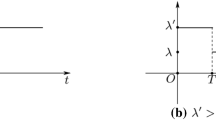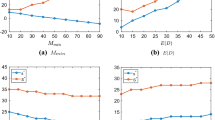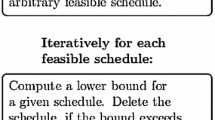Abstract
In the growth stage of a product life cycle, the demand rate is usually unstable and follows an increasing pattern. The traditional inventory policies, which have been developed for stationary demand pattern, are not appropriate to this situation. Although there exist some researches in the past dealing with inventory policy for the case of increasing demand pattern, most of them focused on the inventory systems in which shortages are not allowed. In reality, the presence of shortages is sometimes economically preferable when holding cost is significant as compared with shortage cost. The aim of the research presented in this paper is, therefore, to develop a replenishment policy for inventory systems with nonlinear increasing demand pattern and shortage allowance in such a way that the total demand during a predefined planning horizon can be exactly met. A heuristic technique to help determine the operational parameters for the inventory policy is then developed. In the proposed heuristic technique, the consecutive improvement method developed by Wang (Comput Oper Res, 29:1819–1825, 2002) will first be used to help determine replenishment times. And then, a new concept of reduction cost, which is defined as the difference between the holding cost when shortage is allowed and the incurred shortage cost, is introduced and applied to help find the optimal shortage starting point in each replenishment cycle. Numerical experiments are also conducted to illustrate the applicability of the proposed technique.
Similar content being viewed by others
References
Cox WE Jr (1967) Product life cycles as marketing models. J Bus (Pre-1986) 40(4):375–384
Golder PN, Tellis GJ (2004) Growing, growing, gone: cascades, diffusion, and turning points in the product life cycle. Mark Sci 23(2):207–218
Diponegoro A, Sarker BR (2002) Determining manufacturing batch sizes for a lumpy delivery system with trend demand. Int J Prod Econ 77(2):131–143
Resh M, Friedman M, Barbosa LC (1976) On a general solution of the deterministic lot size problem with time-proportional demand. Oper Res 24(4):718–725
Donaldson WA (1977) Inventory replenishment policy for a linear trend in demand-an analytical solution. Oper Res Q 28(3):663–670
Hariga M (1993) Inventory replenishment problem with a linear trend in demand. Comput Ind Eng 24(2):143–150
Lo WY, Tsai CH, Li RK (2002) Exact solution of inventory replenishment policy for a linear trend in demand-two-equation model. Int J Prod Econ 76(2):111–120
Silver EA (1979) Simple inventory replenishment decision rule for a linear trend in demand. J Oper Res Soc 30(1):71–75
Phelps RI (1980) Optimal inventory rule for a linear trend in demand with a constant replenishment period. J Oper Res Soc 31(5):439–442
Teng JT (1994) A note on inventory replenishment policy for increasing demand. J Oper Res Soc 45(11):1335–1337
Mitra A, Cox JF, Jesse RR Jr (1984) A note on determining order quantities with a linear trend in demand. J Oper Res Soc 35(2):141–144
Ritchie E (1984) The E.O.Q. for linear increasing demand: a simple optimal solution. J Oper Res Soc 35(10):949–952
Yang J, Zhao GQ, Rand GK (1999) Comparison of several heuristics using an analytic procedure for replenishment with non-linear increasing demand. Int J Prod Econ 58(1):49–55
Wang SP (2002) On inventory replenishment with non-linear increasing demand. Comput Oper Res 29(13):1819–1825
Zhou YW, Lau HS, Yang SL (2004) A finite horizon lot-sizing problem with time-varying deterministic demand and waiting-time-dependent partial backlogging. Int J Prod Econ 91(2):109–119
Teng JT, Chern MS, Yang HL (1997) An optimal recursive method for various inventory replenishment models with increasing demand and shortages. Nav Res Logist 44(8):791–806
Murdeshwar TM (1988) Inventory replenishment policy for linearly increasing demand considering shortages-An optimal solution. J Oper Res Soc 39(7):687–692
Dave U (1989) A deterministic lot-size inventory model with shortages and a linear trend in demand. Nav Res Logist 36(4):507–514
Hariga M (1994) The inventory lot-sizing problem with continuous time-varying demand and shortages. J Opl Res Soc 45(7):827–837
Deb M, Chaudhuri K (1987) A note on the heuristic for replenishment of trended inventories considering shortages. J Opl Res Soc 38(5):459–463
Dave U (1989) On a heuristic inventory-replenishment rule for items with a linearly increasing demand incorporating shortages. J Oper Res Soc 40(9):827–830
Yang HL, Teng JT, Chern MS (2002) A forward recursive algorithm for inventory lot-size models with power-form demand and shortages. Eur J Oper Res 137(2):394–400
Yang HL (2006) A backward recursive algorithm for inventory lot-size models with power-form demand and shortages. Int J Syst Sci 37(4):235–242
Chen CK, Hung TW, Weng TC (2007) Optimal replenishment policies with allowable shortages for a product life cycle. Comput Math Appl 53(10):1582–1594
Author information
Authors and Affiliations
Corresponding author
Rights and permissions
About this article
Cite this article
Astanti, R.D., Luong, H.T. A heuristic technique for inventory replenishment policy with increasing demand pattern and shortage allowance. Int J Adv Manuf Technol 41, 1199–1207 (2009). https://doi.org/10.1007/s00170-008-1566-6
Received:
Accepted:
Published:
Issue Date:
DOI: https://doi.org/10.1007/s00170-008-1566-6




